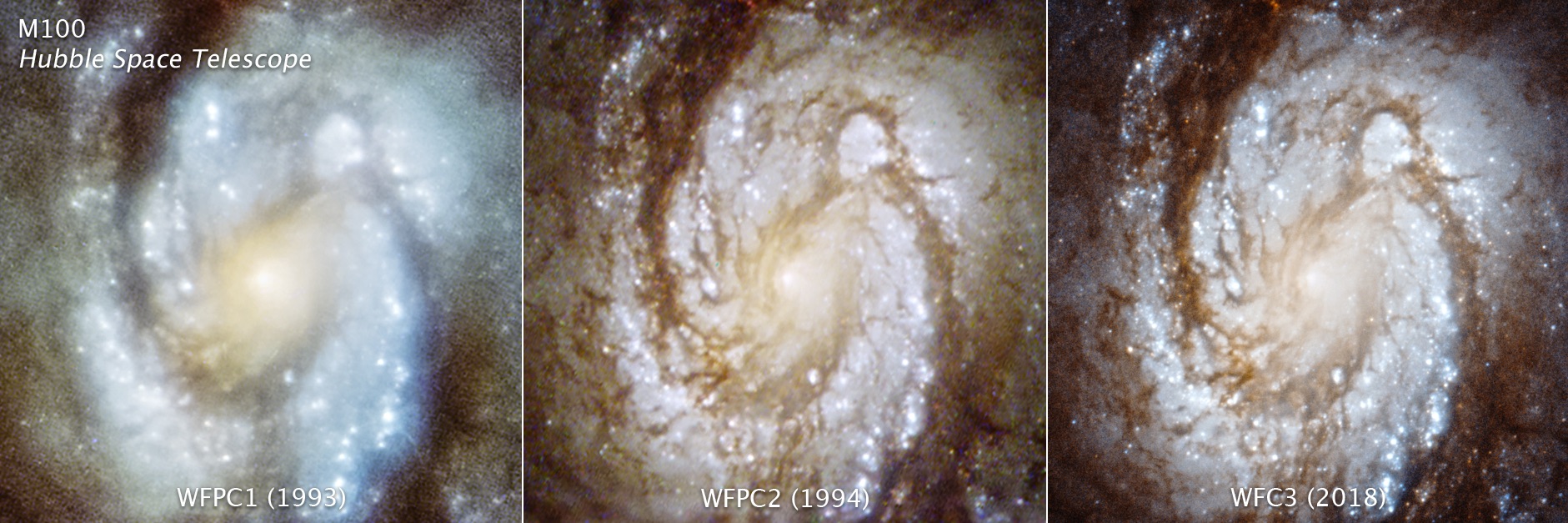This Galaxy Pic from the Hubble Telescope Shows How Astronauts Fixed Its Vision 25 Years Ago

NASA released a stunning new comparison photo to celebrate the anniversary of the first astronaut mission to repair the Hubble Space Telescope's blurry vision, 25 years ago.
Shortly after the space telescope launched, in 1990, NASA discovered a manufacturing flaw in the observatory's primary mirror, and this affected the clarity of the telescope's early images. During a shuttle mission in 1993, astronauts completed a spacewalk to install a replacement instrument to bring Hubble's view back into focus.
In honor of the mission's 25th anniversary, this newly released comparison photo captures three views of the central region of the spiral galaxy M100, which is located about 55 million light-years from Earth. [The Hubble Space Telescope: A 25th Anniversary Photo Celebration]
The image on the left was taken using the Wide Field and Planetary Camera 1, before astronauts swapped out the camera with the vision-corrected Wide Field and Planetary Camera 2, according to a statement from NASA.
Taken in 1994, the middle image used that replacement camera, which was installed during the space shuttle servicing mission STS-61 on Dec. 2, 1993 — the first of five space shuttle flights to upgrade the Hubble Space Telescope.
The Wide Field and Planetary Camera 2 contained corrective optics to compensate for the mirror flaw, giving the observatory a clearer view of the spiral galaxy. Lastly, the image on the right was taken using Hubble's newest instrument, the Wide Field Camera 3, which was installed during the last astronaut servicing mission to the space telescope, on May 4, 2009, according to the statement.
Together, these three images document the "consistently improving capability of the observatory," NASA officials said in the statement. "Because of the astronaut servicing missions, Hubble's capabilities have only gotten better."
Get the Space.com Newsletter
Breaking space news, the latest updates on rocket launches, skywatching events and more!
In the 25 years since STS-61, Hubble has delivered many jaw-dropping photos of the cosmos and contributed to a number of revolutionary discoveries, including the confirmation of the universe's accelerating expansion.
Recently, Hubble took a brief break from observation, from Oct. 5 to Oct. 27, after one of the observatory's orientation-maintaining gyroscopes failed. However, the diligent effort of numerous NASA teams got the telescope back up and running.
While NASA expects Hubble to continue operating through at least 2020, the observatory will not last forever. NASA's James Webb Space Telescope, scheduled for launch in 2021, is considered the successor to Hubble. It's designed to probe the cosmos to uncover the history of the universe.
Follow Samantha Mathewson @Sam_Ashley13. Follow us @Spacedotcom, Facebook and Google+. Original article on Space.com.
Join our Space Forums to keep talking space on the latest missions, night sky and more! And if you have a news tip, correction or comment, let us know at: community@space.com.

Samantha Mathewson joined Space.com as an intern in the summer of 2016. She received a B.A. in Journalism and Environmental Science at the University of New Haven, in Connecticut. Previously, her work has been published in Nature World News. When not writing or reading about science, Samantha enjoys traveling to new places and taking photos! You can follow her on Twitter @Sam_Ashley13.









